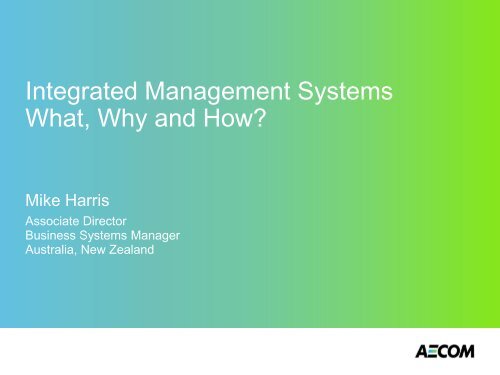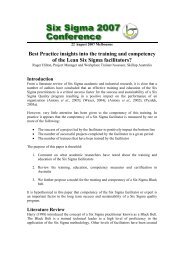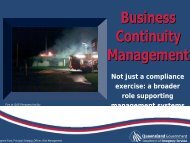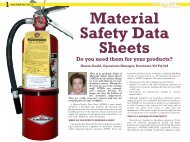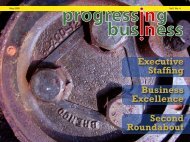What is an IMS - Australian Organisation for Quality
What is an IMS - Australian Organisation for Quality
What is an IMS - Australian Organisation for Quality
You also want an ePaper? Increase the reach of your titles
YUMPU automatically turns print PDFs into web optimized ePapers that Google loves.
Integrated M<strong>an</strong>agement Systems<br />
<strong>What</strong>, Why <strong>an</strong>d How?<br />
Mike Harr<strong>is</strong><br />
Associate Director<br />
Business Systems M<strong>an</strong>ager<br />
Australia, New Zeal<strong>an</strong>d
Who <strong>is</strong> AECOM?<br />
Global leader providing fully integrated professional,<br />
technical <strong>an</strong>d m<strong>an</strong>agement support services in:<br />
Architecture<br />
Building Engineering<br />
Construction Services<br />
Design + Pl<strong>an</strong>ning<br />
Economics<br />
Energy<br />
Environment<br />
Government<br />
Mining<br />
Oil + Gas<br />
Program, Cost, Consult<strong>an</strong>cy<br />
Program M<strong>an</strong>agement<br />
Tr<strong>an</strong>sportation<br />
Water<br />
45,000 employees in 125 countries<br />
20+ offices in Australia <strong>an</strong>d New Zeal<strong>an</strong>d with 4,500 staff<br />
May 18, 2011<br />
Page 2
<strong>What</strong> <strong>is</strong> <strong>an</strong> <strong>IMS</strong><br />
- M<strong>an</strong>agement system <strong>is</strong> the me<strong>an</strong>s by which <strong>an</strong>y<br />
enterpr<strong>is</strong>e sets out to achieve its objectives – m<strong>an</strong>aging<br />
the business not the people in it<br />
- <strong>IMS</strong> <strong>is</strong> <strong>an</strong> integrated overall m<strong>an</strong>agement system of the<br />
enterpr<strong>is</strong>e that includes the systems relating to all<br />
departments <strong>an</strong>d activities that help achieve the overall<br />
objectives.<br />
- All org<strong>an</strong><strong>is</strong>ations have multiple systems but not all are<br />
integrated to achieve the overall objectives – m<strong>an</strong>y are<br />
fragmented <strong>an</strong>d special<strong>is</strong>ed <strong>an</strong>d not linked with each other<br />
May 18, 2011 Page 3
Why consider <strong>an</strong> <strong>IMS</strong><br />
- Reduce duplications, additional costs<br />
<strong>an</strong>d conflicts in developing the<br />
systems separately<br />
- Have a cohesive system supporting<br />
operations <strong>an</strong>d delivering what<br />
comp<strong>an</strong>y needs<br />
- Have single instructions that meet the<br />
needs of all systems e.g. site v<strong>is</strong>it<br />
instruction<br />
People<br />
<strong>an</strong>d<br />
Per<strong>for</strong>m<strong>an</strong>ce<br />
Project<br />
Delivery<br />
In<strong>for</strong>mation<br />
Technology<br />
AECOM<br />
Integrated<br />
M<strong>an</strong>agement<br />
System<br />
Marketing<br />
<strong>an</strong>d<br />
Comms<br />
Safety<br />
Fin<strong>an</strong>ce<br />
- So ch<strong>an</strong>ges address all system needs<br />
<strong>an</strong>d none are m<strong>is</strong>sed<br />
- Have a proactive system, preventing<br />
m<strong>is</strong>takes rather th<strong>an</strong> correcting them<br />
after something happens<br />
A simple case of economics,<br />
org<strong>an</strong><strong>is</strong>ational efficiency <strong>an</strong>d<br />
effectiveness<br />
May 18, 2011 Page 4
Framework of <strong>an</strong> <strong>IMS</strong><br />
- Policy<br />
- Pl<strong>an</strong>ning<br />
Pl<strong>an</strong><br />
- Implementation <strong>an</strong>d operation<br />
- Per<strong>for</strong>m<strong>an</strong>ce Assessment<br />
- Improvement<br />
Do<br />
Check<br />
- M<strong>an</strong>agement Review<br />
Act<br />
May 18, 2011 Page 5
Role of aspects in the Framework<br />
- Aspects are critical <strong>is</strong>sues that<br />
need to be controlled in a process<br />
to ensure a sat<strong>is</strong>factory outcome<br />
- Process opposite helps identify the<br />
aspects <strong>an</strong>d controls <strong>for</strong> <strong>an</strong> <strong>IMS</strong><br />
regardless of department or<br />
activity<br />
- Action to deal with aspects needs<br />
to consider:<br />
• How m<strong>an</strong>y signific<strong>an</strong>t aspects<br />
• Likelihood of immediate serious<br />
repercussions if no action<br />
• Fin<strong>an</strong>cial loss<br />
• Regulatory action<br />
• Business opportunity<br />
Identification of processes<br />
<strong>an</strong>d sub-processes<br />
Identification of inputs<br />
<strong>an</strong>d outputs<br />
Identification of aspects<br />
Prioritization of aspects that<br />
could have signific<strong>an</strong>t impact<br />
Implementation of control<br />
measures<br />
May 18, 2011 Page 6
Communicate <strong>an</strong>d Consult<br />
R<strong>is</strong>k Assessment<br />
Monitor <strong>an</strong>d Review<br />
R<strong>is</strong>k m<strong>an</strong>agement framework (ISO 31000)<br />
Establ<strong>is</strong>h the context<br />
Identify the r<strong>is</strong>ks<br />
Analyse the r<strong>is</strong>ks<br />
Evaluate the r<strong>is</strong>ks<br />
Treat the r<strong>is</strong>ks<br />
May 18, 2011 Page 7
Getting started to implement <strong>an</strong> <strong>IMS</strong><br />
- Analyse the current status <strong>an</strong>d identify <strong>an</strong>y gaps <strong>for</strong> each<br />
aspect against each element <strong>an</strong>d sub-element of the <strong>IMS</strong>.<br />
- Th<strong>is</strong> provides a v<strong>is</strong>ual gap <strong>an</strong>alys<strong>is</strong> to help priorit<strong>is</strong>e the<br />
tasks <strong>for</strong> developing the <strong>IMS</strong>.<br />
May 18, 2011 Page 8
Getting started approach<br />
1. Identification of business needs<br />
2. Policy <strong>an</strong>d its development<br />
3. Identification of processes<br />
4. Identification of business r<strong>is</strong>ks <strong>an</strong>d aspects<br />
5. Prioritization of aspects<br />
6. Determining objectives<br />
7. Gap <strong>an</strong>alys<strong>is</strong> of requirements vs current status<br />
8. Development of action pl<strong>an</strong>s<br />
9. Implementation<br />
10. Operation<br />
11. Per<strong>for</strong>m<strong>an</strong>ce assessment monitoring<br />
12. Improvement<br />
13. M<strong>an</strong>agement Review<br />
May 18, 2011 Page 9
Business needs approach<br />
Each org<strong>an</strong><strong>is</strong>ation <strong>an</strong>d interested parties need to determine what it should strive<br />
<strong>for</strong> in their <strong>IMS</strong> <strong>an</strong>d what <strong>is</strong> acceptable based on its business needs. Taking r<strong>is</strong>ks<br />
<strong>is</strong> part of successful businesses so a bal<strong>an</strong>ce has to be found. Business needs<br />
have to consider concerns of:<br />
- B<strong>an</strong>ks<br />
- Insurers<br />
- Regulators<br />
- Shareholders<br />
- Society<br />
- Work<strong>for</strong>ce<br />
- Statutory business watchdogs<br />
- Customers<br />
- Suppliers/contractors<br />
- Neighbours<br />
May 18, 2011 Page 10
Integrating m<strong>an</strong>agement systems into your <strong>IMS</strong><br />
- Common elements of st<strong>an</strong>dards are in the <strong>IMS</strong> framework<br />
- Aspects <strong>an</strong>d legal requirements are unique to integrating <strong>an</strong><br />
environmental system<br />
• General r<strong>is</strong>k based approach provides a common process <strong>for</strong> these<br />
- Integrating safety introduces legal <strong>an</strong>d statutory requirements to do r<strong>is</strong>k<br />
assessments <strong>an</strong>d implement controls<br />
• E.g. definition of laceration in New Zeal<strong>an</strong>d under ‘serious harm’<br />
- Other systems (e.g. security, corporate responsibility, food) are likely to<br />
have unique requirements that will me<strong>an</strong> reviewing the <strong>IMS</strong> to h<strong>an</strong>dle<br />
them in a similar way to quality, safety, environmental<br />
May 18, 2011 Page 11
<strong>What</strong> does <strong>an</strong> effective <strong>IMS</strong> look like?<br />
- Org<strong>an</strong><strong>is</strong>ation’s objectives are clear<br />
- Job requirements <strong>an</strong>d expectations are clear<br />
- Assur<strong>an</strong>ces about training<br />
- Continual improvement <strong>is</strong> a clear objective <strong>an</strong>d welcomed<br />
- Top m<strong>an</strong>agement support <strong>is</strong> v<strong>is</strong>ible<br />
- Everyone feels involved <strong>an</strong>d owns their tasks<br />
- Fin<strong>an</strong>cial <strong>an</strong>d operational benefits are v<strong>is</strong>ible<br />
May 18, 2011 Page 12
<strong>IMS</strong> <strong>an</strong>d projects<br />
- PMP includes requirements of all st<strong>an</strong>dards<br />
<strong>an</strong>d <strong>is</strong> main link between the business<br />
systems <strong>an</strong>d projects.<br />
- PMP addresses project specific<br />
requirements<br />
May 18, 2011 Page 13
References<br />
HB 139-2003 Guid<strong>an</strong>ce on Integrating the Requirements of <strong>Quality</strong>, Environment, <strong>an</strong>d Health <strong>an</strong>d<br />
Safety M<strong>an</strong>agement System St<strong>an</strong>dards<br />
GB 013.1-2010 Integrated M<strong>an</strong>agement Systems (<strong>IMS</strong>): A Framework <strong>for</strong> Integrated M<strong>an</strong>agement<br />
Systems<br />
GB 013.2-2010 Integrated M<strong>an</strong>agement Systems (<strong>IMS</strong>) - Implementing <strong>an</strong>d Operating Using PAS 99<br />
GB 013.3-2004 Integrated M<strong>an</strong>agement Systems (<strong>IMS</strong>) - Creating a M<strong>an</strong>ual<br />
GB 013.4-2004 Integrated M<strong>an</strong>agement Systems (<strong>IMS</strong>) - Customer Sat<strong>is</strong>faction<br />
GB 013.5-2004 Integrated M<strong>an</strong>agement Systems (<strong>IMS</strong>) - The Excellence Model<br />
GB 013.6-2005 Integrated M<strong>an</strong>agement Systems (<strong>IMS</strong>) - In<strong>for</strong>mation Security<br />
GB 013.7-2005 Integrated M<strong>an</strong>agement Systems (<strong>IMS</strong>) - Continual Improvement through auditing<br />
GB 013.8-2010 Integrated M<strong>an</strong>agement Systems (<strong>IMS</strong>) - Good Govern<strong>an</strong>ce - A r<strong>is</strong>k-based m<strong>an</strong>agement<br />
systems approach to internal control<br />
GB 013.9-2005 Integrated M<strong>an</strong>agement Systems (<strong>IMS</strong>) - M<strong>an</strong>aging Food Safety<br />
May 18, 2011 Page 14
Summary<br />
- An <strong>IMS</strong> needs to be promoted as adding value, not compli<strong>an</strong>ce, to get<br />
staff accept<strong>an</strong>ce<br />
- Tool to reduce duplication, improve efficiencies <strong>an</strong>d ass<strong>is</strong>t all parts of<br />
the org<strong>an</strong><strong>is</strong>ation achieve their objectives <strong>an</strong>d the overall objectives<br />
- <strong>IMS</strong> development <strong>an</strong>d implementation needs to be pl<strong>an</strong>ned with a<br />
systematic approach<br />
- Identifying aspects <strong>an</strong>d r<strong>is</strong>ks after you underst<strong>an</strong>d the core processes<br />
will ass<strong>is</strong>t with priorit<strong>is</strong>ation of tasks needed to be completed to get <strong>an</strong><br />
<strong>IMS</strong><br />
May 18, 2011 Page 15
Questions <strong>an</strong>d general d<strong>is</strong>cussion


